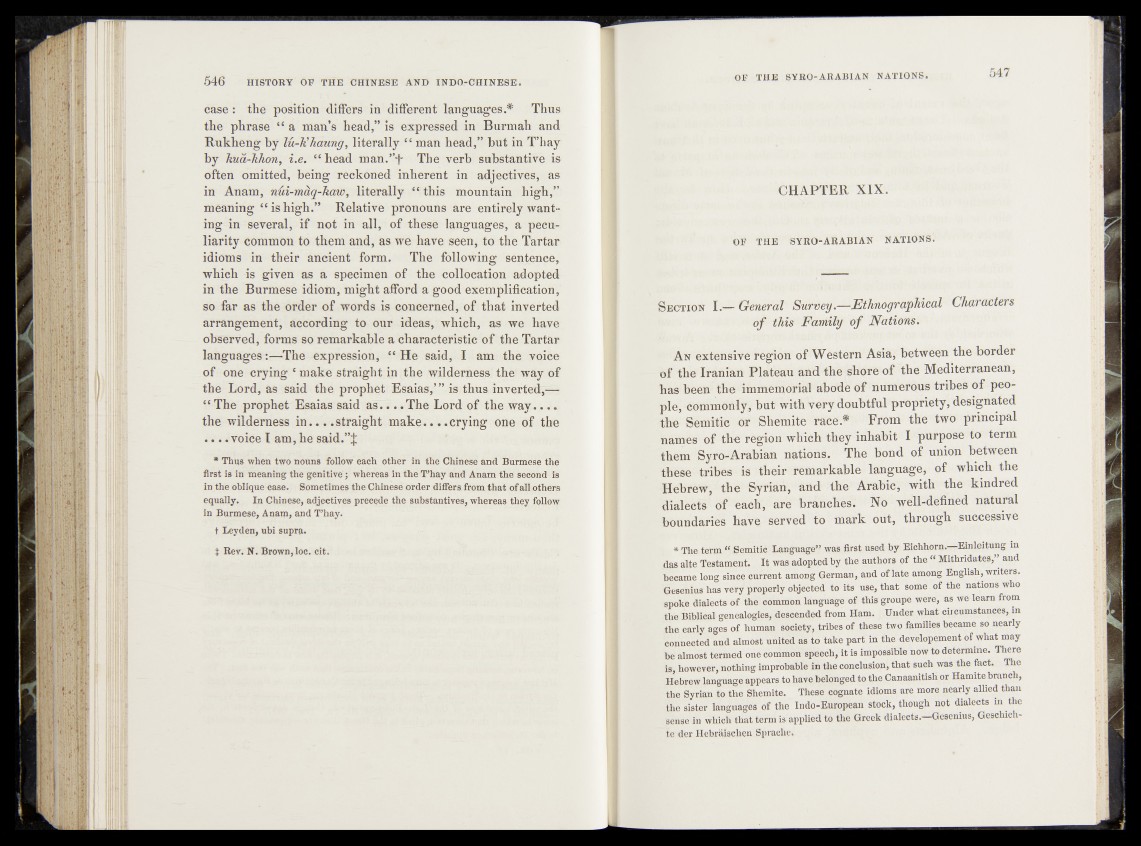
5 4 6 HISTORY ÓR THE CHINESE AND INDU-CHINESE.
case : thé position differs in different languages Thus
the phrase “ a man’s head,” is expressed in Burmah and
Rukheng by lu-Khaung, literally “ man head,” but in T’hay
by kua-hhon, Le. “ head man.”f The verb substantive is
often omitted, being reckoned inherent mil adjectives, as
in Anam, nüi-maq-haw, literally “ this mountain high,”
meaning “ is high.” Relative pronouns are entirely wanti
n g ^ several, if not in all, of these languages, a peculiarity
common to them and, as we have seen, to the Tartar
idioms in their ancient form. The following sentence,
which is given as a specimen of the collocation adopted
in the Burmese idiom, might afford a good exemplification,
so far as the order of words is concerned, of that inverted
arrangement, according to our ideas, which, as we have,
observed, forms so remarkable a characteristic of the Tartar
languagest-^-The expression, “ He said, I am the. voice
of one crying c make straight in the wilderness the way of
the Lord, as said the prophet Esaias,’ ” is thus inverted,^
“ The prophet Esaias said as. . . . The Lord of the way. . . .
the wilderness in .. . .straight make. . . .crying one of the
. . . .voice I am, he said.”J
* Thus when two nouns follow each other in the Chinese and Burmese the
first is in meaning the genitive'; whereas in the T’hay and Anam th é 'second is
in the obliqne case. Sometimes the Chinese order differs, from th a t of all others
equally. La Chinese, adjectives precede the substantives, whereas they follow
in Burmese, Anam, and T’hay.
t Leyden, nbi supra.
t Rev. N. Brown, loc. cit.
OP THE SYRO-ARABIAN NATIONS. 547
CHAPTER XIX.
OF THE SYRO-ARABIAN NATIONS.
S e c t io n I.— General Survey.—Ethnographical Characters
of this Family of Nations.
• An extensive region of Western Asia, between the border
of the Iranian Plateau and the ;shore of the Mediterranean,
has been the>ilnmemoria:l abode of numerous tribes of people,
commonly , but with very doubtful propriety, designated
the Semitic or Shemite race.* From the two principal
names of the region which they inhabit I purpose to term
them Syro-Arabian nations. The bond of union between
these tribes is their remarkable language, of which the
Hebrew, the Syrian, and the Arabic, with the kindred
dialects of each, are branchés. No well-defined natural
boundaries have served to mark out, through successive
* The ferm u Semitic Language” was first used by Eichhorn.—Einleitung in
das alte Testament. I t was adopted by the authors of the “ MithridateS,” and
became long since current among German, anct of late among English, writers.
Gesenius has very properly objected, to its use, th a t some, of the nations who
spoke dialects of the common language of this groupe were, as we learn from
the Biblical genealogies, descended from Ham. Under what circumstances, in
the early ages of human society, tribes of these two families became so nearly
connected and almost united as to take part in fee developemcnt of what may
be almost termed one common speech, it is impossible now to determine. There
is, however, nothing improbable in the conclusion, that such was the (act. The
Hebrew language appears to have belonged to the Canaanitish or Hamite branch,
the Syrian fo the Shemite. These cognate idioms are more nearly allied than
the sister languages of the Indo-European stock, though not dialects in the
sense in which that term is applied to the Greek dialects.—Gesenius, Geschichte
der Hebräischen Sprache.